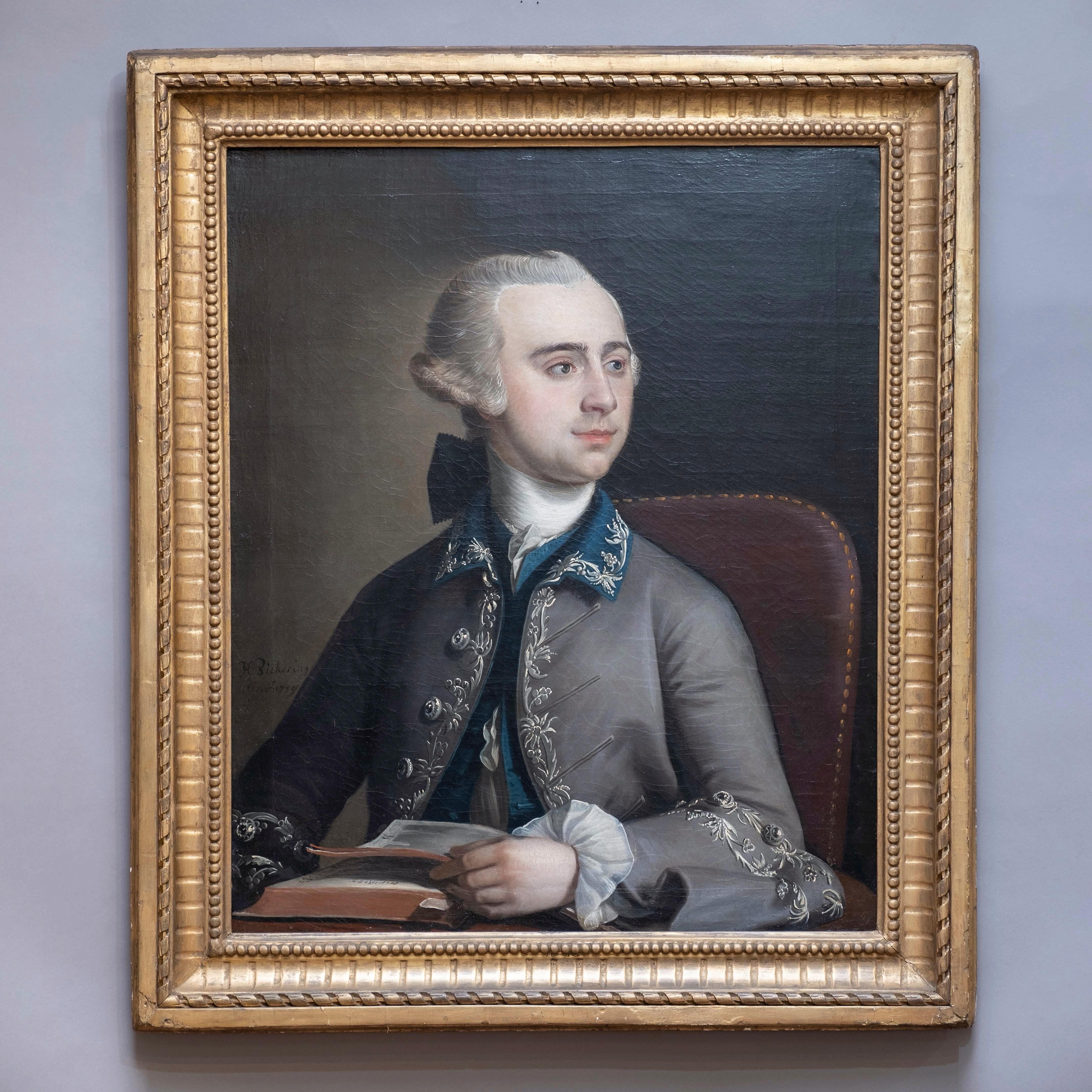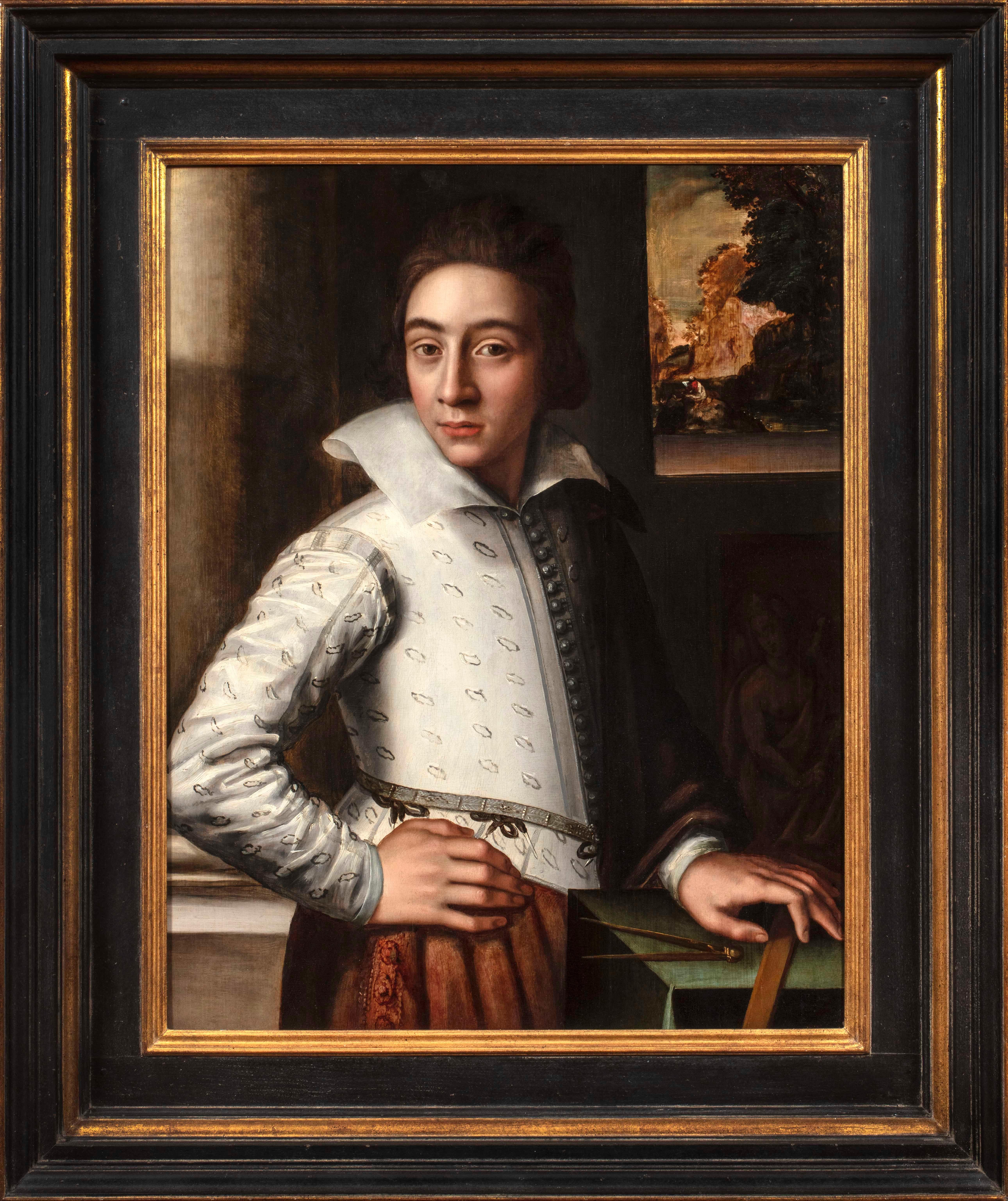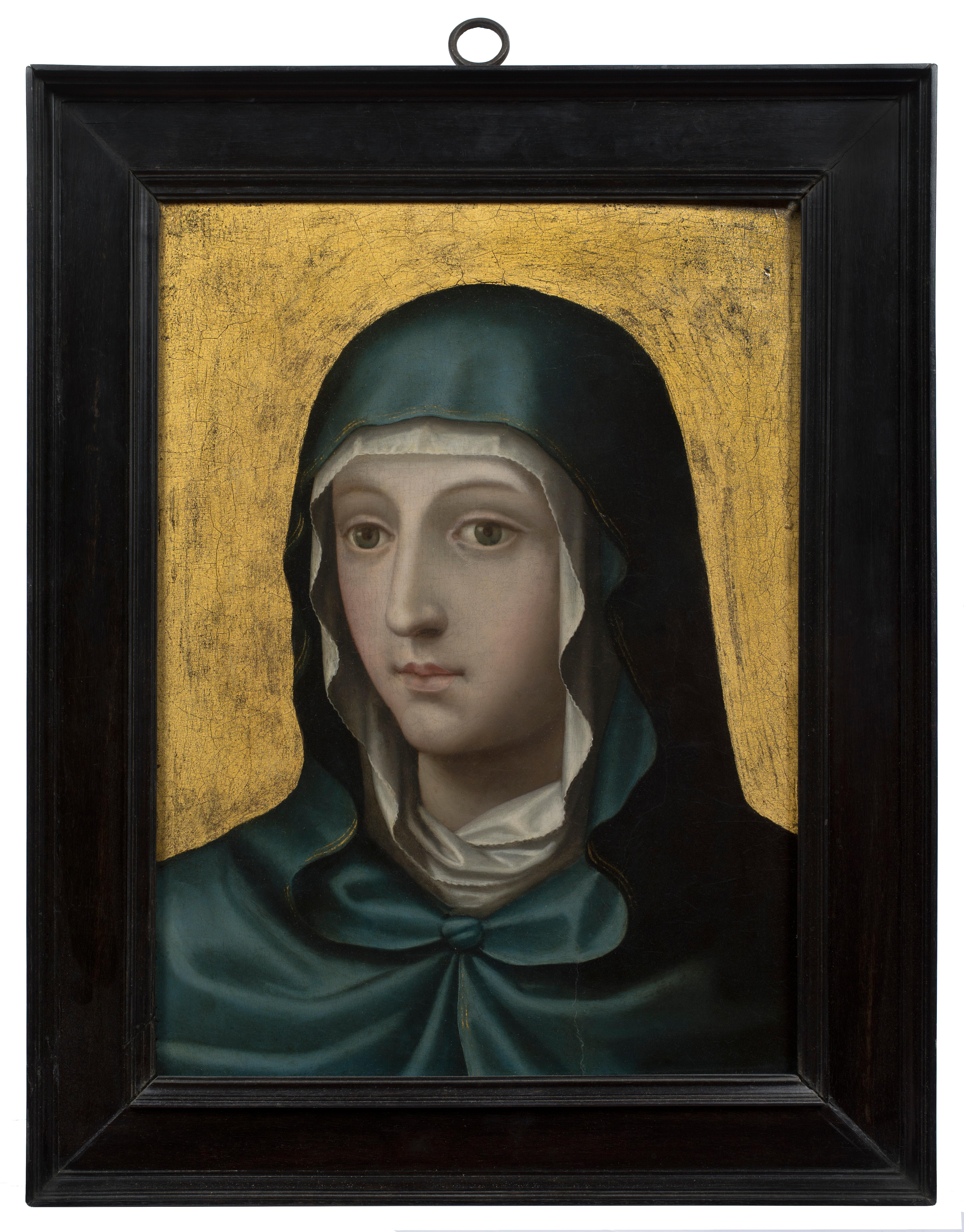Items Similar to Portrait Noblewoman Dog Van Loo Paint 18th Century Oil on canvas Old master Art
Want more images or videos?
Request additional images or videos from the seller
1 of 16
Portrait Noblewoman Dog Van Loo Paint 18th Century Oil on canvas Old master Art1730-1760
1730-1760
About the Item
Louis Michel van Loo (Toulon 1707- Paris 1771) attributable
Portrait of a noblewoman with her little dog
Oil on canvas (79 x 66 cm. - with frame 92 x 78 cm.)
A qualitative portrait depicting an elegant noblewoman of French origin, presumably belonging to the wealthy court of Versailles during the reign of Louis XV; this work fully reflects the pictorial qualities as well as the refinement of the compositional style of the French painter Louis Michel van Loo (1707- 1771), one of the most significant portrait painters of his time, and for this reason in demand at the most noble European courts.
The work, taking up the traditional formula for portraits of members of the aristocracy, shows the effigy in a half-length pose, slightly turned to the right and looking directly at the viewer.
The woman, with a regal bearing, is here portrayed intent on completing her daily beauty ritual, wearing a cape during her make-up, which must have just been completed as pink powder is visible on her cheeks. This luxurious garment reveals a corset with a daring neckline, made of silk and lace, and a coral-coloured dress ending in wide jabote cuffs. Her hair is styled in the French fashion in a hairstyle that highlights her facial features.
Having finished her beauty ritual, the woman is intent on removing her cape with one hand, an elegant gesture that emphasises her noble pose.
At her side is her small pet dog, sitting on a blue velvet cushion with gold trim.
The canvas may have been made on the occasion of a wedding, elegantly celebrating the role of a member of the aristocracy. The presence of the pet depicted in her arms had in fact a precise meaning: the fidelity that is such a well-known characteristic of the dog, declared at the same time the virtues of the effigy.
Louis Michel van Loo (Toulon 1707- Paris 1771) was the son of the painter Jean Baptiste van Loo, with whom he studied in Rome and Turin. He attended the Paris Academy, where he won the first prize for painting in 1726. In 1728 he returned to Rome, where he met Francois Boucher. In 1732, passing through Turin, he returned to Paris. In 1737 van Loo became court painter in Madrid, succeeding Jean Ranc. In that city in 1752 he was one of the founding members of the Academy of Fine Arts. In 1753 he again returned to Paris, where he worked in the service of the royal court. In 1765, he was appointed director of the École Royale des Élèves Protegés at the Académie Royale.
The work is presented in an excellent state of preservation, with a gilded wooden frame.
ADDITIONAL INFORMATION:
The work is sold with a certificate of authenticity in accordance with the law.
We take care of and organise the transport of the purchased works, both for Italy and abroad, through professional and insured carriers.
It is also possible to see the painting in the gallery in Riva del Garda, Viale Canella 18, we will be happy to welcome you and show you our collection of works.
Contact us, without obligation, for any additional information.
- Attributed to:Louis Michel Van Loo (toulon 1707- Paris 1771)
- Creation Year:1730-1760
- Dimensions:Height: 36.23 in (92 cm)Width: 30.71 in (78 cm)
- Medium:
- Movement & Style:
- Period:
- Condition:
- Gallery Location:Riva del Garda, IT
- Reference Number:1stDibs: LU988113774722
About the Seller
4.8
Platinum Seller
These expertly vetted sellers are 1stDibs' most experienced sellers and are rated highest by our customers.
Established in 2017
1stDibs seller since 2018
201 sales on 1stDibs
Typical response time: <1 hour
- ShippingRetrieving quote...Ships From: Riva del Garda, Italy
- Return PolicyA return for this item may be initiated within 7 days of delivery.
More From This SellerView All
- Portrait Woman Princess Diziani Paint 18th Century Oil on canvas Old master ArtLocated in Riva del Garda, ITGaspare Diziani (Belluno 1689 - Venice 1767) Portrait of a Young Princess (Salome?) Oil on canvas 42 x 33 cm Framed 70 x 63 cm A charming portrait of a beautiful young woman with ...Category
18th Century Old Masters Paintings
MaterialsOil
- Terwesten Woman Allegory Art Paint Oil on canvas 17/18th Century Old masterLocated in Riva del Garda, ITMattheus Terwesten (The Hague, 1670 - 1757) Portrait of a young woman with palette and brushes, as Allegory of the art of Painting Oil on canvas 160 x 91 cm. - In frame 178 x 107 cm...Category
17th Century Old Masters Paintings
MaterialsOil
- Perroneau Portrait Lady Woman Paint Oil on canvas 18th Century Old master FrenchLocated in Riva del Garda, ITJean-Baptiste Perroneau (Paris, 1715 – Amsterdam, 1783) Portrait of a lady Oil on oval canvas 60 x 50 cm. - In frame 77 x 66 cm. Work accompanied by expertise: Raffaelle Colace (Cremona), Ferdinando Arisi Reference bibliography: d’Arnoult, Dominique (2014) Jean-Baptiste Perronneau, c 1715-1783, un portraitiste dans l’Europe des Lumières Excerpt from the expertise of Dr. Colace: This refined portrait of a lady is a perfect example of the style of Jean-Baptiste Perroneau, a very talented French painter, whose most beautiful works are located, just like this one, between the fifth and sixth decades of the eighteenth century. "Perroneaeu is more naturally colored than La Tour, the est, in the peinture de poussière colorée, tout plein de tons clairs, frais, presque humides": this is how his brothers wrote about him in La Maison d...Category
18th Century Old Masters Paintings
MaterialsOil
- Portrait Knight Paint Oil on canvas 17th Century Lombard school Old master ItalyLocated in Riva del Garda, ITLombard painter of the 17th century Portrait of a Knight in Armour Oil on canvas 81 x 70 cm./ Framed 93 x 82 A handsome gentleman in armour, immortalised in an authoritative and pr...Category
17th Century Old Masters Paintings
MaterialsOil
- Saint Mark Evangelist Guercino Paint Oil on canvas Old master 17th Century ItalyLocated in Riva del Garda, ITWorkshop of Giovanni Francesco Barbieri, known as Il Guercino (Cento, 1591 - Bologna, 1666) Saint Mark the Evangelist Oil on canvas - 85 x 71 cm., Framed 100 x 86 cm. Of great cha...Category
17th Century Old Masters Paintings
MaterialsOil
- Portrait Gentleman Armor Carbone Van Dyck Paint Oil on canvas 17th Century ItalyLocated in Riva del Garda, ITGiovanni Bernardo Carbone (Genoa, 1616 - 1683), workshop Portrait of a gentleman in armor with battle scene in the background Oil on oval canvas (117 x 105 cm. - In gilded frame 124...Category
17th Century Old Masters Paintings
MaterialsOil
You May Also Like
- Portrait of a ManLocated in New York, NYProvenance: with Leo Blumenreich and Julius Böhler, Munich, 1924 Dr. Frederic Goldstein Oppenheimer (1881-1963), San Antonio, Texas; by whom given to: Abraham M. Adler, New York, un...Category
16th Century Old Masters Portrait Paintings
MaterialsOil, Panel
- Henry Pickering, Portrait of a GentlemanBy Henry PickeringLocated in London, GBHenry Pickering, Portrait of a Gentleman Oil on canvas; signed and dated 1759; held in a giltwood period frame Provenance: Lenygon & Morant Ltd. c.1900; Knoedler, October 1912 (Sto...Category
Mid-18th Century Old Masters Portrait Paintings
MaterialsOil
- Charles Jervas, Portrait of Joseph MellishBy Charles JervasLocated in London, GBCharles Jervas (1675-1739) Portrait of Joseph Mellish (1675-1733) Oil on canvas; held in a carved period frame Dimensions refer to size of frame. Provenance: Blyth Hall, Nottinghamshire, England; by descent to Sir Andrew Buchanan of Hodsock Priory, Nottinghamshire In 1635 John Mellish, a merchant tailor of London, bought the estate of Blyth in Nottinghamshire. His son, a wealthy Oporto merchant, dying unmarried, left Blyth in 1703 to a cousin, Joseph Mellish, who became one of Newcastle’s earliest and most important political supporters in the county. He went up to Clare College, Cambridge in 1692 and on to the Inner Temple the following year. He married Dorothea Gore, daughter of Sir William Gore...Category
Early 18th Century Old Masters Portrait Paintings
MaterialsOil
- Portrait of a GentlemanLocated in New York, NYCircle of Jacques-Louis David (French, 18th Century) Provenance: Private Collection, Buenos Aires Exhibited: “Art of Collecting,” Flint Institute of Art, Flint, Michigan, 23 November 2018 – 6 January 2019. This vibrant portrait of young man was traditionally considered a work by Jacques-Louis David, whose style it recalls, but to whom it cannot be convincingly attributed. Rather, it would appear to be by a painter in his immediate following—an artist likely working in France in the first decade of the nineteenth century. Several names have been proposed as the portrait’s author: François Gérard, Louis Hersent, Anne-Louis Girodet (Fig. 1), Theodore Gericault, and Jean-Baptiste Wicar, among others. Some have thought the artist Italian, and have proposed Andrea Appiani, Gaspare Landi...Category
18th Century Old Masters Paintings
MaterialsCanvas, Oil
- Portrait of an Artist (possibly a Self-Portrait)Located in New York, NYProvenance: Bradley Collection. Private Collection, Upperville, Virginia. Literature: Katlijne van der Stighelen and Hans Vlieghe, Rubens: Portraits of Unidentified and Newly Identified Sitters painted in Antwerp, Corpus Rubenianum Ludwig Burchard, vol. 19, pt. 3, London and Turnhout, 2021, under cat. no. 189, p. 161, and fig. 75. This painting had previously been considered to be by an anonymous Tuscan painter of the sixteenth century in the orbit of Agnolo Bronzino. While the painting does in fact demonstrate a striking formal and compositional similarity to Bronzino’s portraits—compare the nearly identical pose of Bronzino’s Portrait of a Young Man in the Metropolitan Museum of Art (Fig. 1)—its style is completely foreign to Italian works of the period. That it is painted on an oak panel is further indication of its non-Italian origin. This portrait can in fact be confidently attributed to the Antwerp artist Huybrecht Beuckelaer. Huybrecht, the brother of Joachim Beuckelaer, has only recently been identified as the author of a distinct body of work formerly grouped under the name of the “Monogrammist HB.” In recent studies by Kreidl, Wolters, and Bruyn his remarkable career has been delineated: from its beginnings with Joachim in the workshop of Pieter Aertsen; to his evident travels to Italy where, it has been suggested, he came into contact with Bronzino’s paintings; to his return to Antwerp, where he seems to have assisted Anthonis Mor in painting costume in portraits; to his independent work in Antwerp (where he entered the Guild of Saint Luke in 1579); and, later to his career in England where, known as “Master Hubberd,” he was patronized by the Earl of Leicester. Our painting was recently published by Dr. Katlijne van der Stighelen and Dr. Hans Vlieghe in a volume of the Corpus Rubenianum, in which they write that the painting “has a very Italian air about it and fits convincingly within [Beuckelaer’s] oeuvre.” Stighelen and Vlieghe compare the painting with Peter Paul Ruben’s early Portrait of a Man, Possibly an Architect or Geographer in the Metropolitan Museum of Art, in which the sitter holds a compass and wears a similarly styled doublet (Fig. 2). Huybrecht both outlived and travelled further afield than his brother Joachim, who made his career primarily in Antwerp. Whereas Joachim was the main artistic inheritor of their uncle and teacher, Pieter Aertson, working in similar style and format as a specialist in large-scale genre and still-life paintings, Huybrecht clearly specialized as a painter of portraits and was greatly influenced by the foreign artists and works he encountered on his travels. His peripatetic life and his distinctly individual hand undoubtedly contributed to the fact his career and artistic output have only recently been rediscovered and reconstructed. His periods abroad seem to have overlapped with the mature phase of his brother Joachim’s career, who enrolled in the Antwerp Guild of Saint Luke much earlier than his brother, establishing himself as an independent painter in 1560. Joachim’s activity was confined to the following decade and half, and his latest work dates from the last year of his life, 1574. Our portrait was likely produced in the late 1560s, a dating supported by the dendrochronological investigation performed by Dr. Peter Klein, which established that it is painted on an oak panel with an earliest felling date of 1558 and with a fabrication date of ca. 1566. This painting presents a portrait of an artist, almost certainly Huybrecht’s self-portrait. The young sitter is confidently posed in a striking patterned white doublet with a wide collar and an abundance of buttons. He stands with his right arm akimbo, his exaggerated hands both a trademark of Huybrecht and his brother Joachim’s art, as well as a possible reference to the “hand of the artist.” The figure peers out of the painting, interacting intimately and directly with the viewer, as we witness him posed in an interior, the tools and results of his craft visible nearby. He holds a square or ruler in his left hand, while a drawing compass...Category
16th Century Old Masters Paintings
MaterialsOil, Panel
- The Veronica of the Virgin (Verónica de la Virgen)Located in New York, NYThe panel has been attributed both to Joan de Joanes and his son Vicente Macip Comes (Valencia, ca. 1555 – 1623). Provenance: Private Collection, England, by 1886 (according to stencils on the reverse) Private Collection, New Jersey, until 2010 The Veil of Veronica, often called the Sudarium, is one of the most important and well-known relics of Christ. According to legend, Veronica offered Christ her veil as he carried the cross to his crucifixion. He wiped his face with the veil, which left the cloth miraculously imprinted with his image. Depictions of Christ’s face on a veil, or simply images that focused in on Christ’s face, were treasured objects of religious devotion. The popularity of this format also inspired similar images of the face of the Virgin. The iconographic type of the present painting is known as the Veronica of the Virgin, which was especially favored in late medieval and early Renaissance Spain. Distinct from the images of the suffering Christ, the Veronica of the Virgin is based on the legend that Saint Luke painted a portrait of Mary from life. Although scholars have sometimes mistaken them for portraits of Queen Isabella I of Castile (known as Isabel la Católica) or as a depiction of Saint Maria Toribia (known as María de la Cabeza, or, Mary of the Head), paintings like this one were clearly intended as images of the Virgin in the style of Saint Luke’s lost portrait. The Veronica of the Virgin was especially popular in Valencia, and depictions of this subject produced there all stem back to one visual prototype: a Byzantine image in the city’s cathedral (Fig. 1). This early treatment of the Veronica was given to the cathedral in 1437 by Martin the Humane, King of Aragon and Valencia, who promoted religious veneration of the Veronica of the Virgin as part of the celebration of the Immaculate Conception of Mary. This devotion spread throughout Martin’s kingdom and particularly took hold in Valencia, where the Byzantine image resided. The image, which is displayed in a gold reliquary...Category
16th Century Old Masters Paintings
MaterialsOil, Wood Panel
Recently Viewed
View AllMore Ways To Browse
Kevin Chair
Cincinnati Art Carved
Impressionist Society
19th English Oil Landscape
1998 Small Abstract Painting
Cows Dutch Masters
Contemporary Acrylic Standing Abstract Figure
Painting Snake Charmer
Tim Hooper
Baroque Oil Painting Frame
Italian Car Art
From The Corner Of The Eye
French Countryside Oil Art
Baroque Style Painting
Horse Men In The Country
Revival Home Paintings
Antique Oil Paintings Round
Thors Oil Landscape Joseph





